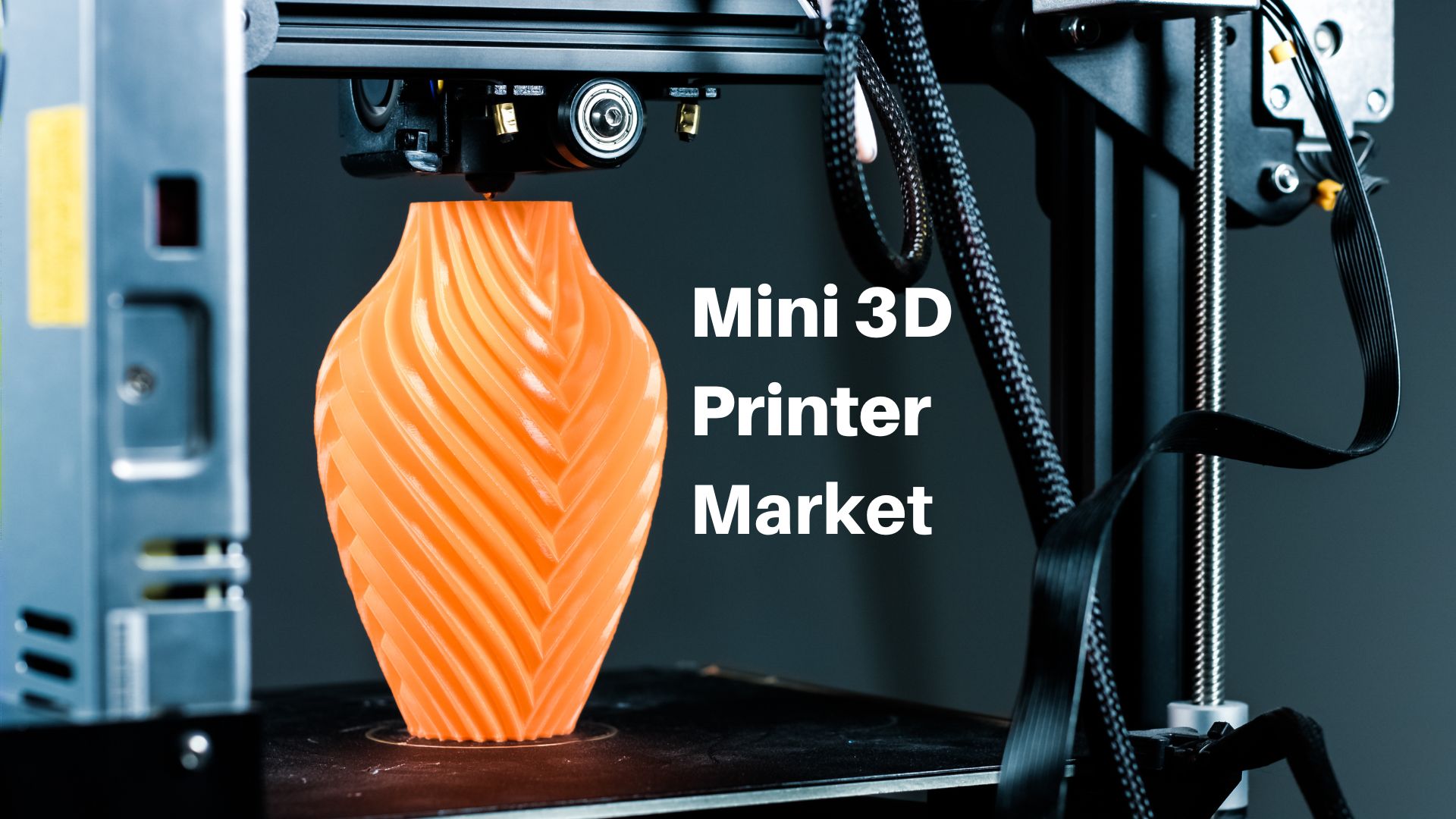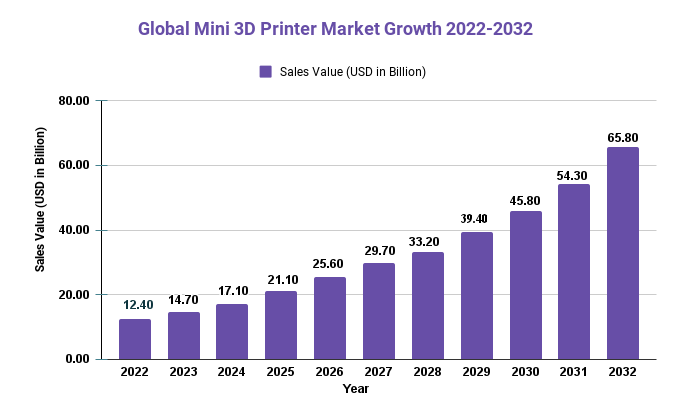Mini 3D Printer Market Size USD 65.8 Bn | Vendors Analysis (Ingenico, Verifone) By 2032

Page Contents
Market Overview
Published Via 11Press: The mini 3D printer market is a rapidly expanding segment within the larger 3D printing industry. These printers are typically desktop-sized devices designed for personal or small business use and can be utilized for prototyping, product design, and even educational applications. As mini 3D printing becomes more widely adopted and new use cases emerge, this market is expected to experience substantial growth over the coming years.
In 2022, the mini 3D printer market was estimated to be worth USD 12.4 billion and reach its peak value of USD 65.8 billion by 2032 at a compound annual growth rate (CAGR) of 18.7% between 2022 and 2032.

Key Takeaways
- The mini 3D printer market is an expanding sector within the larger 3D printing industry.
- These printers typically measure small desktop-sized units designed for personal or small business use.
- Mini 3D printers are becoming more widely used for prototyping, product design, and even educational projects.
- The market for mini 3D printers is expected to expand significantly over the coming years as more people discover its capabilities and new applications arise.
Regional Snapshot
The mini 3D printer market is a global phenomenon, with manufacturers and distributors located around the world. North America currently leads this category due to its high level of innovation and adoption there. Europe and Asia-Pacific also play an important role in this space with growing demand from both commercial and consumer segments.
Drivers, trends, and challenges have an impact on market dynamics, which can impact businesses. Request for PDF sample report
Drivers
- There has been an uptick in demand for mini 3D printers from small businesses, hobbyists, and educational institutions.
- Recent advances in 3D printing technology–materials, software, and hardware–have further fuelled this growth.
- 3D printing is seeing an uptick in various industries, such as healthcare, aerospace, automotive, and architecture.
- These benefits include reduced waste generation, speedy prototyping, and greater customization options.
Restraints
- The high initial cost of purchasing and running 3D printers.
- The limited material range that can be used in 3D printing compared to traditional manufacturing methods.
- Challenges in scaling up 3D printing technology for large-scale production lines.
- Concerns have been expressed over the environmental effects of 3D printing, particularly with respect to waste generation and energy consumption.
In conclusion, the mini 3D printer market is experiencing explosive growth due to demand from small businesses, hobbyists, and educational institutions. While there are challenges such as high initial costs of purchasing and running 3D printers, limited material options, and concerns over its environmental impact that need to be addressed, these markets are expected to keep expanding.
Opportunities
- Competitive Prices: Mini 3D printers have become more cost-effective, making it easier for individuals and small businesses to break into the 3D printing market.
- Customization: Mini 3D printers offer the unique opportunity to craft personalized and unique products, which is especially beneficial for small businesses and individuals looking to stand out in a crowded market.
- Rapid Prototyping: Mini 3D printers enable rapid prototyping, saving businesses both time and money during the product development process.
- Education: The use of mini 3D printers in schools and universities has grown increasingly popular, offering students a chance to explore 3D printing technology and gain valuable skills that will serve them well in their future careers.
Challenges
- Limited Size and Capabilities: Mini 3D printers have smaller build volumes and materials they can use, which may present a challenge for those needing to print larger or more complex objects.
- Printing Speed: Mini 3D printers tend to be slower than their larger counterparts, which may pose a challenge for businesses with high production demands.
- Quality Control: As mini 3D printers become more cost-effective and accessible, quality control of the products they produce may suffer.
- Limited Market Potential: The mini 3D printer market is still relatively small, which could limit the customer base available to businesses operating in this space.
Recent Developments
- Miniature 3D Printing Pens: A new generation of miniature 3D printing pens has recently entered the market, providing hobbyists and artists with a more portable and affordable option for 3D printing projects.
- Advanced Materials: Mini 3D printers are now capable of printing with a wider variety of materials, such as composites, metals, and ceramics.
- Software Improvements: The software used to operate mini 3D printers has become more user-friendly and intuitive, making it simpler for individuals and businesses alike to design and print objects.
- Enhancing Speed and Accuracy: Mini 3D printers have become faster and more accurate due to advances in technology and materials.
Key Market Segments
Type
- Desktop 3D Printer
- Handheld 3D Printer
Application
- Home Use
- Commercial Use
Key Market Players
- 3D Printing Systems
- M3D LLC
- LulzBot
- Tiertime
- MakerBot
- Holy Laser
- Holy Laser
Report Scope
| Report Attribute | Details |
| The market size value in 2022 | USD 12.4 Bn |
| Revenue forecast by 2032 | USD 65.8 Bn |
| Growth Rate | CAGR Of 18.7% |
| Regions Covered | North America, Europe, Asia Pacific, Latin America, and Middle East & Africa, and Rest of the World |
| Historical Years | 2017-2022 |
| Base Year | 2022 |
| Estimated Year | 2023 |
| Short-Term Projection Year | 2028 |
| Long-Term Projected Year | 2032 |
Frequently Asked Questions
Q: What can I use a mini 3D printer for?
A: Mini 3D printers can be used for a wide range of applications, including prototyping, hobbyist projects, small-scale production, and educational purposes.
Q: How much does a mini 3D printer cost?
A: Mini 3D printers can range in price from a few hundred to several thousand dollars, depending on the brand and features.
Q: What types of materials can be used with a mini 3D printer?
A: Mini 3D printers are typically limited to using PLA and ABS plastics, although some models can also print with other materials such as wood, metal, and composites.
Q: What software do I need to operate a mini 3D printer?
A: Most mini 3D printers come with their own software, but there are also several free and paid options available, such as Cura and Simplify3D.
Q: What is the maximum size of objects that can be printed with a mini 3D printer?
A: The maximum size of objects that can be printed with a mini 3D printer varies by model, but is generally smaller than larger 3D printers. Most mini 3D printers have a build volume of less than 200mm x 200mm x 200mm.
The team behind market.us, marketresearch.biz, market.biz and more. Our purpose is to keep our customers ahead of the game with regard to the markets. They may fluctuate up or down, but we will help you to stay ahead of the curve in these market fluctuations. Our consistent growth and ability to deliver in-depth analyses and market insight has engaged genuine market players. They have faith in us to offer the data and information they require to make balanced and decisive marketing decisions.